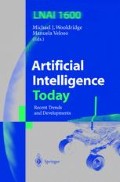Abstract
Believability is one of the key concerns when developing synthetic characters in intelligent virtual environments. To achieve believability, the virtual characters must behave consistently with their assumed or perceived personality.
This paper describes a model for the construction of believable emotional characters with synthetic personae in intelligent virtual environments. The model assumes that personality and emotions are essentially the same mechanism and allows the definition of the characters personality by a set of emotional reactions. The system designer defines a set of concepts, which structure is inspired by Ortony, Clore and Collins’s theory of emotions, that will then automatically integrated in the IVE character cycle, inspired by Fridja’s theory of emotions. Then, the system designer implements the final IVE specific characteristics around those concepts. The methodology was applied to a real time IVE, S3A, developed in the context of the last world exposition of the century, EXPO’98, which featured two pathematic dolphins, Tristão and Isolda, who lived in the synthetic estuary of the river Sado during the four months of the EXPO’98, and were displayed to more than one million visitors.
The project showed that the followed approach is a viable solution for the creation of the synthetic personae of believable emotional agents in intelligent virtual environments.
Access this chapter
Tax calculation will be finalised at checkout
Purchases are for personal use only
Preview
Unable to display preview. Download preview PDF.
References
Bates, J.: The Role of Emotion in Believable Agents. Technical Report CMU-CS-94-136, Carnegie Mellon University (1994).
Badler, N., Reich, B., Webber, B.: Towards Personalities for Animated Agents with Reactive and Planning Behaviours. in Creating Personality for Synthetic Actors, Trappl, R., Petta, P. (eds), Springer-Verlag (1997).
Cañamero, D.: Modelling Motivation and Emotions as a Basis for Intelligent Behavior. Proceedings of Autonomous Agents 97 Conference, Johnson, L., Hayes-Roth, B. (eds), ACM Press. (1997).
Damásio, A.: Descartes’ Error. Publicações Europa-América (1994).
Fridja, N.: Emotions. Cambridge University Press (1987).
Grand, S., Cliff, D., Malhotra, A.: Creatures: Artificial Autonomous Software Agents for Home Entertainment. Proceedings of Autonomous Agents 97 Conference, Johnson, L., Hayes-Roth, B. (eds), ACM Press. (1997).
Hayes-Roth, B., Robert, van G.: Story-Making with Improvisational Puppets and Actors. Technical Report KSL-96-24, Stanford University (1995).
Hayes-Roth, B., van Gent, R., Huber, D.: Acting in Character. in Creating Personality for Synthetic Actors, Trappl, R., Petta, P. (eds), Springer-Verlag (1997).
International Personality Item Pool: Big-Five Factor Analysis Internet Site. http://www.ipip.com (1997).
Johnson, L., Rickel, J., Stiles, R., Munro, A.: Integrating Pedagogical Agents into Virtual Environments. to appear in Journal Presence (1998).
Lester, J., Towns, S., FitzGerald, P.: Achieving Affective Impact: Visual Emotive Communication in Lifelike Pedagogical Agents. To appear in International Journal of AIED special issue on ITS’98 (1999).
Loyall, A., Bates, J.: Real-time Control of Animated Broad Agents. Proceedings of the 15th Annual Conference of the Cognitive Science Society (1993).
Maes, P., Darrell, T., Blumberg, B., Pentland, A.: The ALIVE System: Wireless, Full Body Interaction with Autonomous Agents. in Multimedia Systems Vol.5, Rangan P. (ed), ACM/Springer (1995).
Martinho, C: Emotions in Motion. MSc Thesis, Universidade Técnica de Lisboa, IST (1999).
Moffat, R.: Personality Parameters and Programs. in Creating Personality for Synthetic Actors, Trappl, R., Petta, P. (eds), Springer-Verlag (1997).
Ortony, A., Clore, G., Collins, A.: The Cognitive Structure of Emotions. Cambridge University Press (1988).
Paiva, A., Machado, I.: Vincent, an Autonomous Pedagogical Agent for On-the-Job training. Proceedings of ITS’98 Conference, Lecture Notes in Computer Science, Goettl, B., Halff, H., Redfield, C, Shule, V. (eds), Springier-Verlag (1998).
Petta, P., Trappl, R.: Personalities for Synthetic Actors: Current Issues and Some Perspectives. in Creating Personality for Synthetic Actors, Trappl, R., Petta, P. (eds), Springer-Verlag (1997).
Reilly, W.: Believable Social and Emotional Agents. PhD Thesis, Carnegie Mellon University (1996).
Rousseau, D., Moulin, B.: Personality in Computer Characters. Technical Report KSL 96–13, Stanford University (1996).
Team Technology: Myers-Briggs Internet Site. http://www.team-technology.com (1997).
Terzopoulos, D., Rabie, T., Grzeszczuk, R.: Perception and Learning in Artificial Animals. Proceeding of Artificial Life V Conference on the Synthesis and Simulation of Living Systems, (1996).
Author information
Authors and Affiliations
Editor information
Editors and Affiliations
Rights and permissions
Copyright information
© 1999 Springer-Verlag Berlin Heidelberg
About this chapter
Cite this chapter
Martinho, C., Paiva, A. (1999). “Underwater Love” Building Tristão and Isolda’s Personalities. In: Wooldridge, M.J., Veloso, M. (eds) Artificial Intelligence Today. Lecture Notes in Computer Science(), vol 1600. Springer, Berlin, Heidelberg. https://doi.org/10.1007/3-540-48317-9_11
Download citation
DOI: https://doi.org/10.1007/3-540-48317-9_11
Published:
Publisher Name: Springer, Berlin, Heidelberg
Print ISBN: 978-3-540-66428-4
Online ISBN: 978-3-540-48317-5
eBook Packages: Springer Book Archive

